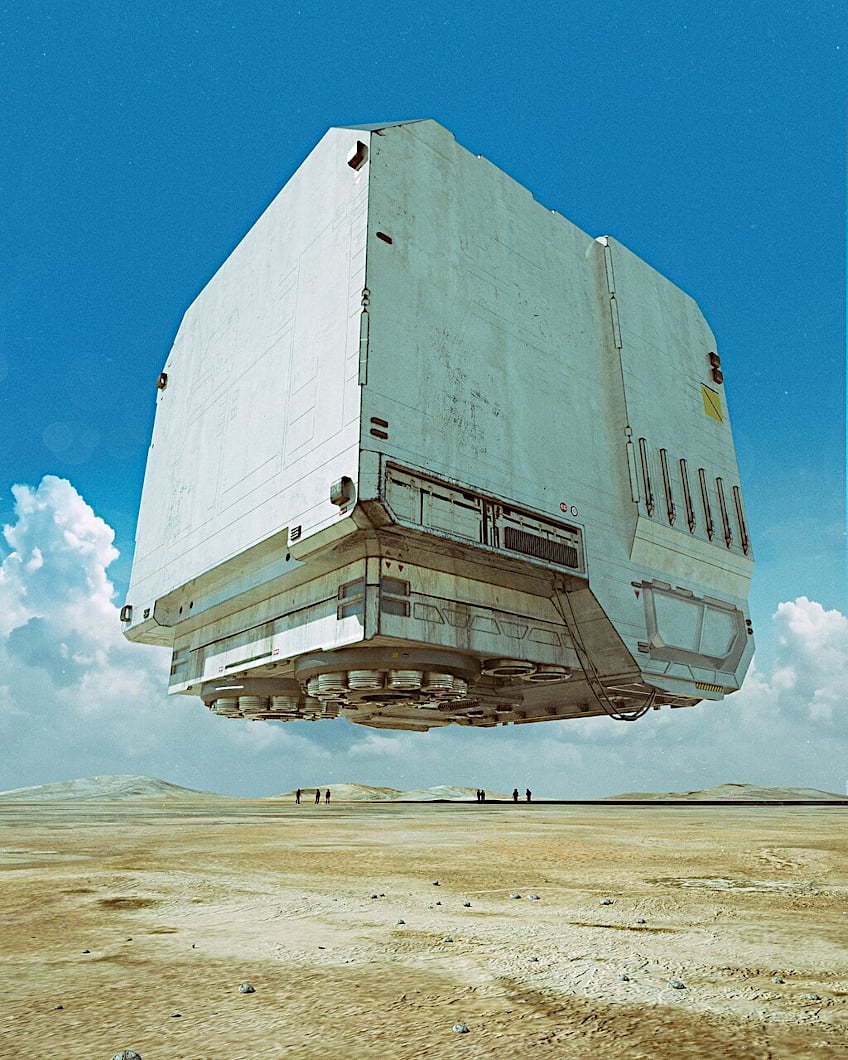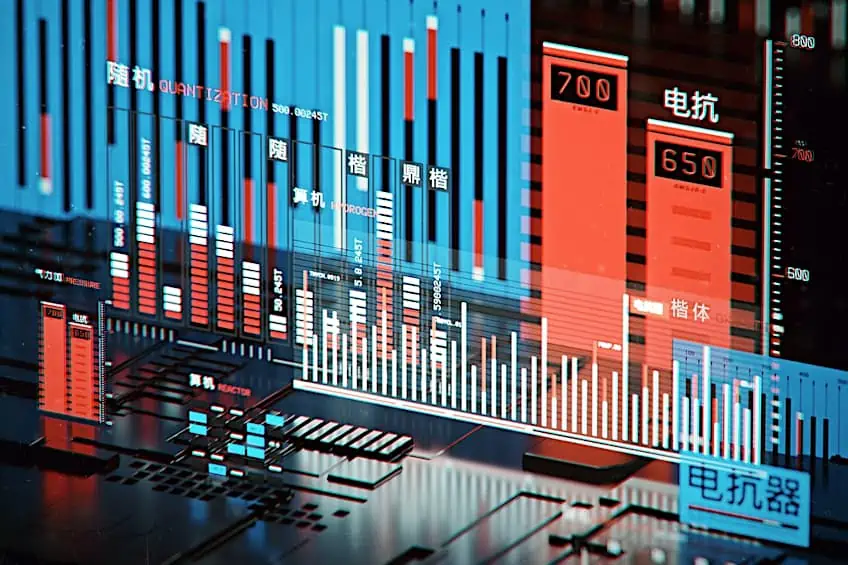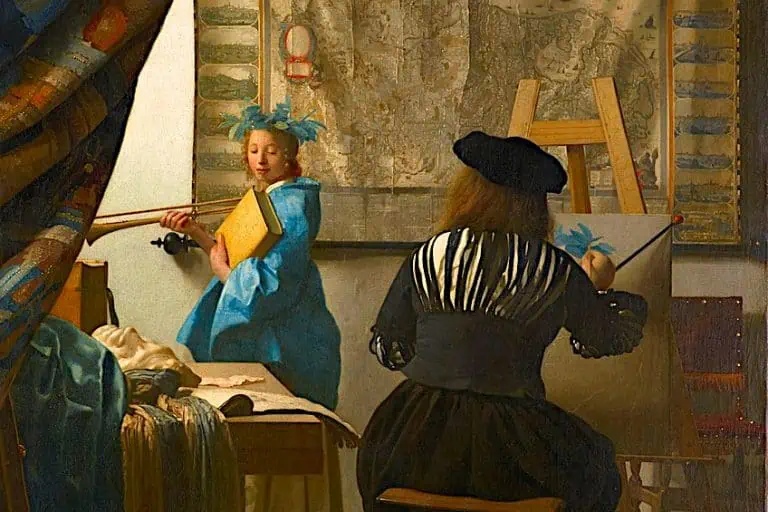What Is Digital Art? – Guide to Technology-Based Artforms
This post may contain affiliate links. We may earn a small commission from purchases made through them, at no additional cost to you.
What is digital art, how does digital art work, and when was digital art invented? The turn of the 20th century saw an increase in the use of new media in art, which is presently understood as digital art. In this article, we will dive into the history of digital art since its emergence, and help answer your questions on the nature of digital art and the authenticity of the medium in the Contemporary art discourse. Read on to learn more about digital art, and keep up with the latest technological developments in art!
Table of Contents
An Introduction to the Digital Art Movement
What is digital art, what is a digital artist, and how does digital art work? These are just a few brewing questions you may have when it comes to understanding the shift from traditional media to modern media in art.
In the contemporary sense, digital art is understood as art produced using any form of digital technology in its production or display.
This means that if an artist incorporated digital technology or computational methods into their art practice, they would be considered a digital artist.
 Human One by Beeple (2021) is a four-channel sculptural and video digital generative artwork designed to evolve over time; Beeple, CC BY-SA 4.0, via Wikimedia Commons
Human One by Beeple (2021) is a four-channel sculptural and video digital generative artwork designed to evolve over time; Beeple, CC BY-SA 4.0, via Wikimedia Commons
Art that interacts with digital media is generally accepted as digital art and has existed since the 1960s. Other names for digital art that you may be familiar with include new media art, electronic art, computer art, and multimedia art. While the artists of the 1960s did not have the advanced digital tools we have today, they still relied on dominant forms of technology such as the computer, video camera, and early graphics software.
A History of Digital Art
When was digital art invented, and what was the digital art movement? Definitions of digital art include art that is produced or presented using any form of digital technology. To appreciate and study art that involves any form of computer processing is also understood as digital art. However, the inclusion of digital technology has also presented a new avenue of thinking for cultural theorists and art scholars, who fundamentally understand digital art as a medium that has significantly altered our perceptual experience and understanding of representation.
Along with the digital art movement came a term known as the “digital condition”, in which there was a significant loss of trust in the idea of the image produced by an artist.
Digital art also suggests alternative ways of experiencing and understanding the world and can be processed by understanding it as a breakdown of the traditions between the artwork, its creative process, the artist, and the audience. As such, the digital representation of visual art has led to subsequent studies on the appropriate appreciation given to digital artwork and its relationship with the digital revolution.
 The Metaverse Museum by László Ördögh Diabolus (Velazquez Bonetto); Mirabella, CC BY-SA 4.0, via Wikimedia Commons
The Metaverse Museum by László Ördögh Diabolus (Velazquez Bonetto); Mirabella, CC BY-SA 4.0, via Wikimedia Commons
While there is evidence of digital art originating in the 1960s, the term itself was first used in the 1980s when a paint program was developed by computer engineers and piloted by the digital artist Harold Cohen. Before this, John Whitney developed her first computer-generated artwork in the 1960s by incorporating mathematical procedures to produce an artwork. This was followed by Ivan Sutherland in 1963, who is credited with inventing the first user-interactive computer graphics interface called Sketchpad.
Harold Cohen’s program was called AARON and was understood as a robotic device that was used to design large drawings on pieces of paper, prepared on the floor. This mechanical device was the first form of artificial intelligence used in art practice, which saw Cohen further develop the program into a more sophisticated tool.
Initially, one can understand digital art from the mid-20th century to be a tool that was used to generate artwork. However, today it is understood as a tool used to enhance the artwork and create an interactive experience of it.
 Irrational Geometrics digital art installation by Pascal Dombis (2008); Cracksinthestreet, Public domain, via Wikimedia Commons
Irrational Geometrics digital art installation by Pascal Dombis (2008); Cracksinthestreet, Public domain, via Wikimedia Commons
In the 1980s, artists such as Andy Warhol produced digital art using an Amiga. Warhol used the device to capture an image of Debbie Harry in monochrome using a video camera, which was then digitized into a graphics program called ProPaint. This enabled Warhol to manipulate the color of the image using flood fills.
With the advanced technological improvements that emerged in the 1990s, digital art saw a major shift from computer-generated and drawn artworks to programs that enabled artists to manipulate the images and videos that they had filmed.
In addition to traditional media, artists now had a new level of creative freedom that enabled them to cut and paste images within moving scenes and produce digital collages. This resulted in digital art adopting a more interactive approach, which also allowed the audience a certain amount of control over the result of the artwork. There has also been a widespread consensus in the arts that digital art and technology have contributed to the expansion of creative expression across the globe, which has opened the doors of art to non-academic artists. Today, there are still a few critics who question the validity of digital art and consider the question “Is digital art real art?”.
Questioning the Validity of Digital Art
As one might expect from any radical shift in the art world, digital art has also gained significant criticism and has been questioned for its position as a medium that could be perhaps construed as “anything but art”. It is then important to examine the question “Is digital art real art?”.
Digital art and the incorporation of technology to produce creative artwork as a means of expression can most definitely qualify as art.
However, digital art can also be viewed as an avant-garde art form of the 20th century, which has rapidly gained acceptance into the mainstream art sector since the late 1900s. While the subject of digital art, including its many innovations such as artificial intelligence and augmented reality, as part of artistic production, continues to be a subject of critical debate.
 Everydays – july 2016 1 by Beeple/ Michael Joseph Winkelmann (2016); Mike Winkelmann, CC BY 4.0, via Wikimedia Commons
Everydays – july 2016 1 by Beeple/ Michael Joseph Winkelmann (2016); Mike Winkelmann, CC BY 4.0, via Wikimedia Commons
The many important philosophical questions about digital art, including computer technology, computer art, digital cinema, and video games, which have formed the foundations of the aesthetics of digital art. Digital works that are considered “pure”, include interactive forms such as digital installations and video games, the latter of which is the latest digital work to be recognized as an art form with incredible potential. Of important note is the mechanics of video games, which many museums have borrowed to produce interactive art experiences.
The broad makeup of digital art is also important to grasp since it relies on computer-based encoding, electronic storage, and the processing of digital data in various formats. This data is processed into common binary codes made up of images, numbers, texts, and sounds. Digital artwork, such as digital photographs, can also be a product of a manipulated image produced by a digital camera, which captured a real-life scene.
One can also consider films to be the product of a complex series of decisions that rely on digital and analog methods, used to capture sound and images. These critical decisions also include composition, image and sound editing, sound mastering, color correction, projection, display, and special effects. Considering that digital art can also encompass representational and abstract art is another complex layer to understand. It is thus difficult to say that digital art cannot be considered art, since it relies on technology, which is simply used as a tool and medium to communicate forms of artistic expression.
 Digital Arabesques by Miguel Chevalier (2014); Miguel Chevalier, CC BY-SA 4.0, via Wikimedia Commons
Digital Arabesques by Miguel Chevalier (2014); Miguel Chevalier, CC BY-SA 4.0, via Wikimedia Commons
Defining a Digital Artist
Now that you have a broad-based understanding of what digital art is and how it qualifies as an art form, you can now dive into our critical discussion of how we define a digital artist in the 21st century. So, what is a digital artist? Who qualifies to use the label “digital artist”? The first visual examples of. Digital art created using an analog computer emerged in the mid-1950s in Germany and the United States. There have also been various experiments using oscilloscope imagery before the development of electronic graphics. A point of interest concerning digital art and who is considered a digital artist is why these early inventions were considered art in the first place. From an art historical perspective, art movements such as Dada, Cubism, Futurism, and kinetic art had already emerged in the 20th century as dominant art forms.
In the United States, Abstract Expressionism emerged alongside early digital art, and as such, digital art was characterized by its relationship with computers and further broken down into understanding art as a process and not just a result.
The creator behind any digital visual product could have also been a non-professional artist, who produced non-representative art forms, and yet also considered a digital artist in the Western world. It is, therefore, fair to conclude that the first artists behind digital artworks of computer-generated images were computer scientists, engineers, and mathematicians, who developed their own theoretical viewpoints and aesthetics for creating visual images using a computer. Among the first examples of computer drawings, considered digital art, were found much later in Soviet Latvia, during the late 1960s.
 Manga-style image created on an oscilloscope; Robert Anders from Hamburg, Germany, CC BY 2.0, via Wikimedia Commons
Manga-style image created on an oscilloscope; Robert Anders from Hamburg, Germany, CC BY 2.0, via Wikimedia Commons
Oscillography, for example, involves the graphic recording of physical shifts in waveforms with changing currents such as voltages and currents, which can be interpreted as sound waves. Figures such as Benjamin Francis Laposky pioneered computer art and began experimenting with oscilloscopes after World War II. He first produced artworks known as Oscillons, which did not involve a computer, however, it did use algorithmic signals to produce an artwork. Laposky later produced an abstract digital artwork using a cathode ray oscilloscope combined with electrical and electronic circuits, as well as sine wave generators in the 1950s.
He referred to his works as “electronic abstractions”, which were photographed and presented as digital and physical artworks. Digital artists thus make use of technology and various media to produce artworks that can be experienced digitally or were produced using digital tools.
Digital Art vs. Drawing
Is digital art difficult, and is digital art easier than drawing? While in some cases, digital drawing can become a lot easier for many who have been exposed to digital media since an early age. Learning digital drawing may differ in difficulty depending on the individual’s experience with digital software and access. Drawing on the other hand can be a challenge to many since the margins for error and undoing a mistake are quite fine.
 Example of software used to create 3D digital art: Screenshot of Blender 2.45 with 3D image of “Suzanne” under construction (2007); Ausis, GPL, via Wikimedia Commons
Example of software used to create 3D digital art: Screenshot of Blender 2.45 with 3D image of “Suzanne” under construction (2007); Ausis, GPL, via Wikimedia Commons
In digital drawing, one can alter and amend their errors much quicker without restarting the artwork. Aspects of drawing such as layering, coloring, and shading are easier to achieve in digital mediums than drawing. With this in mind, is digital art easier for beginners? It is important to remember that, as a beginner, you would still need to study and master basic artistic skills to become proficient with the different software.
It is also easier to begin working in digital art if you are short on space, since traditional art media usually requires a dedicated work area with art equipment.
Exploring the Different Digital Art Types
So, how does digital art work? To further unpack what digital art encompasses, it is useful to explore the different digital art types that have become the face of digital art itself. Below, we have listed the top five digital art types from the 21st century that continue to dominate the digital art scene.
 Holographic Interface by Beeple/Michael Joseph Winkelmann (2014) consists of various 2D bars and labels projected into space to create a layered 3D effect; beeple, CC BY 4.0, via Wikimedia Commons
Holographic Interface by Beeple/Michael Joseph Winkelmann (2014) consists of various 2D bars and labels projected into space to create a layered 3D effect; beeple, CC BY 4.0, via Wikimedia Commons
2D and 3D Digital Painting
One of the most popular forms of digital art is 2D digital painting, which replicates the traditional methods of painting and is usually executed on a tablet with a stylus to provide artists with an authentic experience. Various digital software also comes equipped with different styles of brushes and other drawing tools, which make drawing convenient.
As one develops their skills in 2D digital painting, one can eventually achieve the same likeness visually to paintings created with traditional mediums.
Additionally, one can also use multiple layers to make painting more convenient and allow one room for error without destroying the artwork.
 BOXXX-3W by Beeple (2017); Mike Winkelmann, CC BY 4.0, via Wikimedia Commons
BOXXX-3W by Beeple (2017); Mike Winkelmann, CC BY 4.0, via Wikimedia Commons
Most artists also explore 3D painting to create a more textural and sculptural digital artwork that truly brings the work to life. In 3D painting, one gets to experiment with 3D modeling to produce work that appears hyper realistic or animated. 3D sculpture is another interesting form of digital art that enables one to manipulate a digital model with ease.
Digital art can therefore encompass animated projects, which can be seen in the productions of famous animation studios such as Studio Ghibli.
Algorithmic Art
This form of digital art is a generative art type that relies on autonomous algorithms to produce visual images. To grasp the medium, one needs to understand code to develop algorithmic art.
With some of these software products, artists are not required to make any inputs for the painting process.
This type of digital art is commonly used to design logos, word art, computer-generated images, and various digital assets. Algorithmic art also incorporates vectors as opposed to pixels, which allows one to resize the artwork. For realism-led projects, one can also use a deterministic algorithm.
 Designer using computer software to create a logo; Stock image
Designer using computer software to create a logo; Stock image
Artificial Intelligence Art
Generative digital art can also be produced using generative artificial intelligence programs to transform text into visual images. Popular AI tools include DALL-E and DALL-E 2, which incorporate Diffusion AI technologies and Clip to provide a more realistic experience with digital art.
 A computer-generated image featuring a house at sunset, made in Blender, a free and open-source 3D computer graphics software toolset; Mayqel, CC BY-SA 2.5, via Wikimedia Commons
A computer-generated image featuring a house at sunset, made in Blender, a free and open-source 3D computer graphics software toolset; Mayqel, CC BY-SA 2.5, via Wikimedia Commons
Another well-known tool is Midjourney, which can produce hype realistic images based on textual prompts. One can also leverage the prompts to alter the artwork’s color and lighting.
CGI Art
CGI art refers to computer-generated imagery that is created as artwork and is one of the most popular tools in digital art and animation.
CGI is commonly used in movie production processes and involves the use of dynamic and static images using 3D computer graphics.
In CGI, one is also able to resize, shape, and rotate the graphics with ease. Images are initially produced on a computer screen and then developed into virtual skeletons. CGI is also used in engineering and architecture to imitate real-world models.
 CGI-generated scene from Oliver Stone’s 2014 film Alexander showing Alexander the Great entering Babylon; Oliver Stone, CC BY-SA 4.0, via Wikimedia Commons
CGI-generated scene from Oliver Stone’s 2014 film Alexander showing Alexander the Great entering Babylon; Oliver Stone, CC BY-SA 4.0, via Wikimedia Commons
Pixel Art
Among the most famous digital art types is pixel art, which is commonly used to create 2D assets and can be used to create detailed artwork.
Pixel art involves the application of pixels into simple shapes and detailed objects to create art that is both hyperrealistic and simplified.
The versatile medium grew in popularity for its roots in Cubism and Surrealism and has also been used in early computer games, video game backgrounds, and character development. The term “8-bit” was also adopted to refer to pixel art in the late 20th century. Famous software for pixel art includes Pixen and Krita.
While there are many different digital art types to explore, these top five digital art types are the ones that continue to dominate the digital art scene. In studying the foundations and history of digital art, you can appreciate the many innovative ways that artists and computer scientists have leveraged technology to produce unique digital artworks.
Frequently Asked Questions
What Is Digital Art?
Artwork that is produced using any digital media or tools is recognized as part of digital art and encompasses a diverse set of techniques and approaches. Different types of digital art forms incorporate digital software to produce both two and three-dimensional artworks.
What Are Other Terms for Digital Art?
The term digital art has been described by many artists as computer art, new media art, electronic art, and multimedia art. This describes artwork produced and/or presented using digital technology.
When Was Digital Art Invented?
While there have been experiments with early forms of digital art, it is generally agreed upon that digital art was invented in the 1960s. By the 1980s, digital art had become more mainstream in the art world.
In 2005, Charlene completed her wellness degrees in therapeutic aromatherapy and reflexology at the International School of Reflexology and Meridian Therapy. She worked for a company offering corporate wellness programs for several years before opening her own therapy practice. In 2015, she was asked by a digital marketer friend to join her company as a content creator, and it was here that she discovered her enthusiasm for writing. Since entering the world of content creation, she has gained a lot of experience over the years writing about various topics such as beauty, health, wellness, travel, crafting, and much more. Due to various circumstances, she had to give up her therapy practice and now works as a freelance writer. Since she is a very creative person and as a balance to writing likes to be active in various areas of art and crafts, the activity at acrylgiessen.com is perfect for her to contribute their knowledge and experience in various creative topics.
Learn more about Charlene Lewis and about us.







